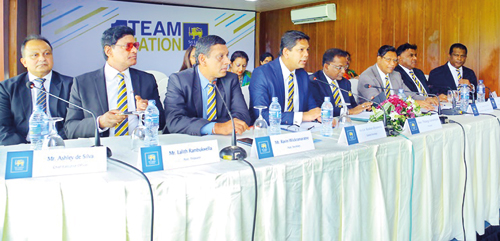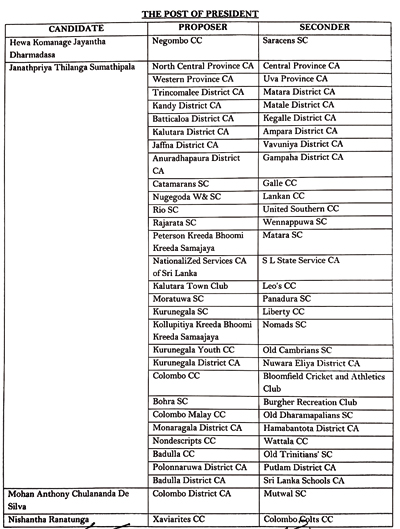Why Sri Lanka Cricket needs a new Constitution
View(s):
The SLC big wigs heading the Emergency General Meeting in front of its affiliated members
Annual general meetings are a dime a dozen, especially in the sports scene. At the same time, AGMs differ according to circumstances. There are some organisations which are forced to seek political patronage — especially assistance from the ruling party politician, if not, the said sport will have no means of existence. They exist through the meagre handouts that the ruling-party politician in the governing body could wangle through the Sports Minister and other important individuals and organisations.
Then there sports organisations that are dollar-rich through assistance from the sports’ mother organisations, and they too, are strong and riddled with their own kind of inner politics, but beyond the precincts of their headquarters, they are merely mundane, because the sport is not sufficiently vibrant to harness public imaginations – like soccer in Sri Lanka.
Then you get the Amateur Athletic Association of Sri Lanka (AAASL). They may not be rupee-rich but, it has a vibrant impact because athletics has managed to capture the attention of the public and mainly, almost on that same ticket, the NOC has its own domain and also its own firebrand politics to keep it ignited 24×7.
Yet, cricket is a different kettle of fish. Cricket always had political patronage. Initially, it was not because people sought to gain an inch through the sport but, it was an entertaining experience for a top politician to be associated with the game of cricket. Ironically, that was during the pre World-Cup-winning era. Since then, the scale has tilted and the game of cricket has never been the same again.
Colloquially, it is said that the International Cricket Council (ICC) — the ruling body of the game of cricket — abhors political interference. But, today, Sri Lanka Cricket (SLC) is embroiled in politics of the lowest kind. If you are to be the president of local cricket’s governing body, you either have to be a super-rich entrepreneur who should be sufficiently influential to warm the heart of the President or the Prime Minister of the country, to receive the nod in his favour or, be an active politician himself, with the correct political affiliations.
However, in the present context, Thilanga Sumathipala and his nemesis Arjuna Ranatunga are both ruling party politicians, but still, Sumathipala has better credentials and more clout within the SLFP despite being a National List MP, after losing the 2015 general elections. Meanwhile, Ranatunga, who duly won his seat on the UNP ticket, which really won the crucial general elections, is groping in the cricketing dark.
Once again, talking of the ICC and their fastidious vows about being anti-politics, the ICC is still blind to what is taking place in Sri Lanka.
Sumathipala, while he was a vibrant member of the ruling SLFP ensemble and the Deputy Speaker, enjoyed a more than healthy relationship with the then Sports Minister Dayasiri Jayasekera, who willingly effected certain changes to the to the Sports Law, which is now stands in good stead towards Sumathipala’s re-election strategies, like tailoring the eligibility criteria to enable a member of the mass media to contest and be an office bearer. It was a crafty bit of tinkering that could ward off any potential threats in the future. I wonder how the ICC would translate these pieces of tinkering and brand them as non-political tampering.
In the SLC circular sent to the stakeholders, the list has some odd spots.
Generally, there are genuine clubs born out of cricket, and began to sprout plainly as a result of their affiliation to cricket and, up to now, they are cricket playing clubs. It should be the biggest criteria. The club should be linked to and be a part of the game and, in turn, it becomes a feeder-point to the national grid. Clubs such as SSC, NCC, Colts, Bloomfield, CCC, BRC, Tamil Union, Moors and Saracens to name a few, are the forerunners of this process. Then the services sector too, has been a part of the development plan of cricket for ages.
Nevertheless, Sumathipala, using his visionary skills craftily, formed the Provincial Associations and the District Associations. On the face of it, it is the future of the game. But, the way these Provincial Associations and District Associations are structured, it is a cricketing masquerade. Just imagine, in the Uva Province, the President and the Secretary are members of parliament — Vijithamuni de Zoysa and Dilan Perera respectively, two career politicians and close buddies of Sumathipala. I just mentioned one, the list is longer. Surely, they have better things to do in politics, than pad up and bat.
The other day a friend came up with a fitting cue. He said, “Thilanga cleverly tailored the Provincial and District system. It has many advantages for Sumathipala. On one hand, he develops a close ally from his own political party. A front that would keep in good stead, in case there is an upheaval in the ‘well’. At the same time, when you develop a vote base of this nature, it stands forever. Right now, one third of Sumathipala’s AGM is won, and he only needs a few more from the real cricket playing base. So why worry?”
 Then, in the melee, there are some clubs which have switched their allegiance. It was not long ago when Bloomfield C&AC faced a mass exodus of its cricketing seniors which impacted on their performances and a steady decline ensued. The crime the club committed was to vote against the Sumathipala-led clique at the last AGM. But recently, when I walked into the clubhouse, there was sprucing up going on pell-mell. On inquiry, I found out that SLC had give them Rs 4 million for infrastructure development. Hey presto! Come the nominations for the forthcoming AGM, Bloomfield is one of the seconders of Thilanga Sumathipala’s nomination for the post of president. I learn handouts have been given to all stakeholders.
Then, in the melee, there are some clubs which have switched their allegiance. It was not long ago when Bloomfield C&AC faced a mass exodus of its cricketing seniors which impacted on their performances and a steady decline ensued. The crime the club committed was to vote against the Sumathipala-led clique at the last AGM. But recently, when I walked into the clubhouse, there was sprucing up going on pell-mell. On inquiry, I found out that SLC had give them Rs 4 million for infrastructure development. Hey presto! Come the nominations for the forthcoming AGM, Bloomfield is one of the seconders of Thilanga Sumathipala’s nomination for the post of president. I learn handouts have been given to all stakeholders.
The most hilarious thing is that, though at an AGM you need only one proposer and one seconder, there were 28 proposers and 28 seconders for Sumathipala’s candidature. In addition, one of the seconders may not be eligible to attend the AGM. Nomads Sports Club has not played any kind of cricket for the past few years, I mean even the Division III tournament, and now they are not invited to take part in the tournament. Once the Nomads’ plot of land was taken over by the government to build Nelum Pokuna, the club gradually degenerated to a nameboard in the Municipal Council. Yet, I wonder, if SLC was sufficiently magnanimous to reward the Nomads with the handout that Bloomfield received for infrastructure development. Surely, for defunct Nomads — now living the real meaning of the word — to come up as a seconder to certain name, there should have been a valid reason.
Now I understand why a host of former cricketers are grouping to march forward, in a bid to effect some changes and make certain changes to the SLC constitution, so that, it could live up to the ideologies that the ICC cherish.



